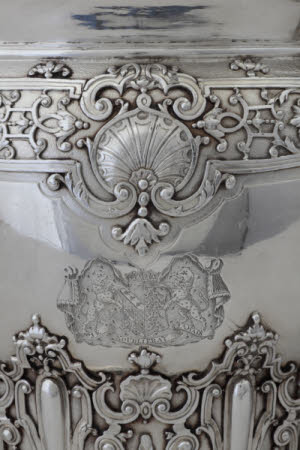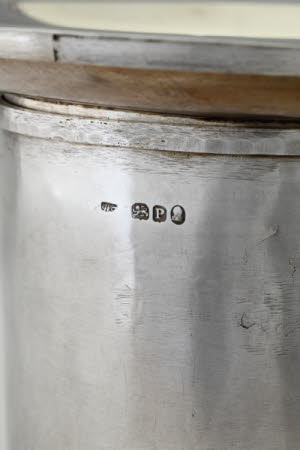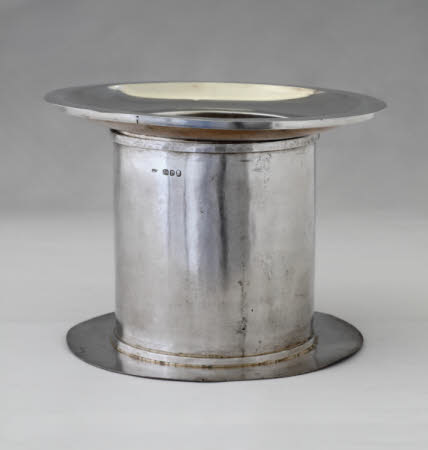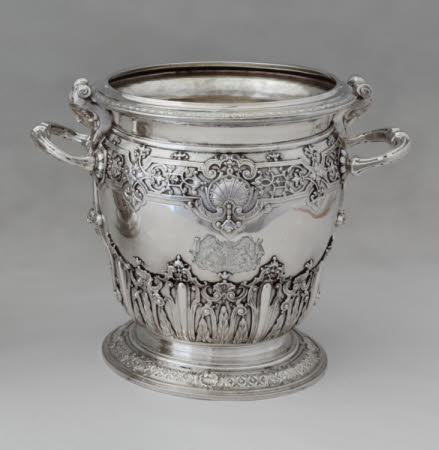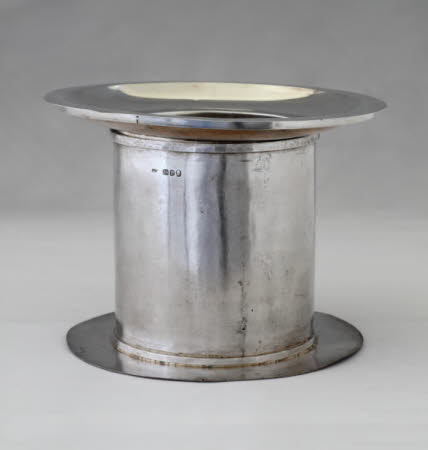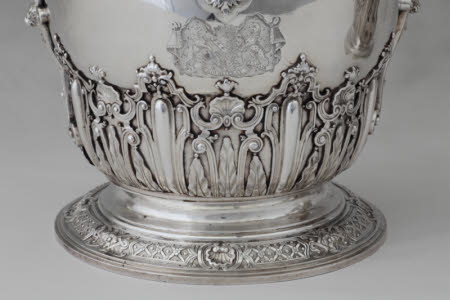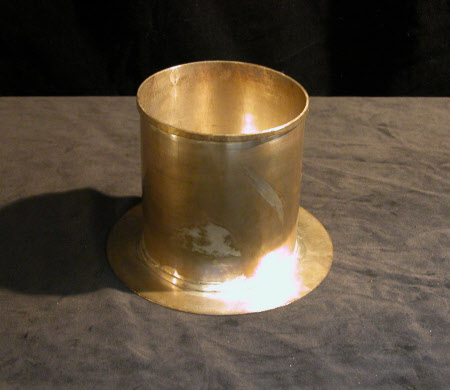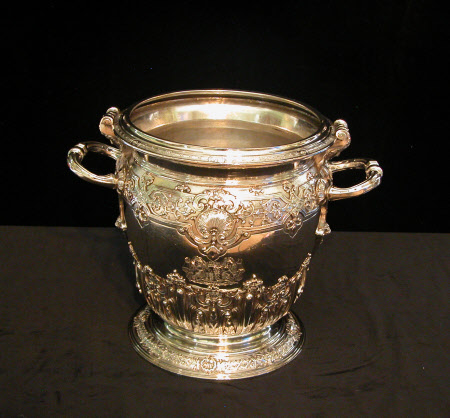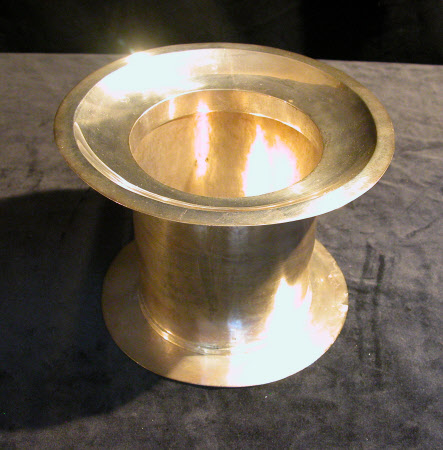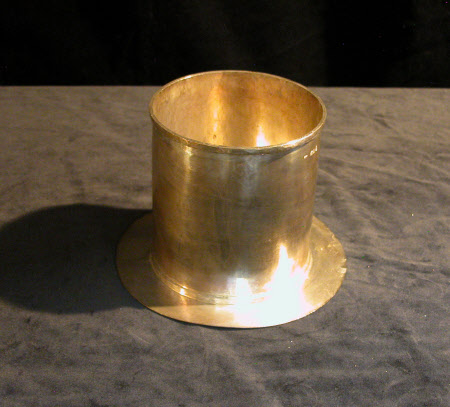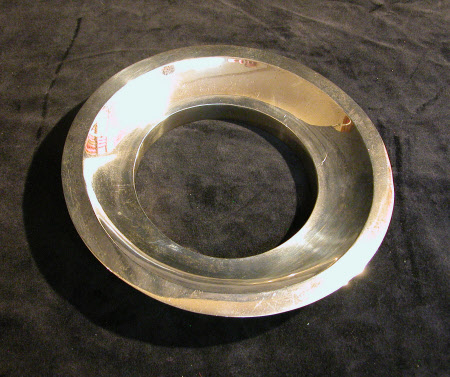Pair of ice pails with later liners
Philip Rollos II
Category
Silver
Date
circa 1730 - 1811
Materials
Ice pails: probably Britannia silver Liners: Sterling silver
Measurements
26.7 x 34.6 cm; 24 cm (diam at rim)
Place of origin
London
Order this imageCollection
Ickworth, Suffolk
NT 852069
Summary
Pair of ice pails, probably Britannia silver, by Philip Rollos, London, c.1730, with sterling silver liners by William Fountain, London, 1810/11. The bodies of the ice pails are raised and of circular bombé form, the lower part matted and applied with nine-pin ribs and elaborate cast and chased strapwork, shells and lanceolate palm leaves. The pails are pinched-in beneath the rim, the undecorated, everting neck being a separate, seamed piece with the soldered joint disguised by a plain wire. Below the wire is another, broad band of rich strapwork on a matted ground with central shell cartouches on either side. The cast and faceted baluster handles with foliate roses are fixed onto plain strips of silver over the upper strapwork band. Thick lateral straps with lion masks are applied to either side and rise from the foot through the handles to the rim, terminating with classical masks against inward-facing volutes. The rim, which steps in, is cast and chased with bands of husks between rosette medallions. The lower part of the spreading foot is cast and chased with panels of floral trelliswork, strapwork and four sculpted shells in C-scroll cartouches. Both pails are in excellent condition. Each liner comprises a seamed circular sleeve which has plain square wires top and bottom and is soldered to a flat base plate with a larger diameter in order to rest against the sides of the pail. The plain rims are raised and have dished profiles, narrow flat outer edges and wide central openings conforming with applied seamed bezels. A rectangular seamed wire is applied under the outer edge of each rim to give strength and to secure it in position in the pail. The liners and one of the rims have punch marks (one and two) as do the pails, to identify the correct compositions. Heraldry: On one side of each pail, between the bands of strapwork, have been re-engraved c.1751 the quartered shield, supporters and motto of the 2nd Earl of Bristol in an ermine mantling and beneath an earl’s coronet. Hallmarks: Ice pails - maker’s mark ‘R O’ either side of an anchor in a shield, struck on the underside of each, four times on one and five on the other. This is an unregistered version of Philip Rollos II’s first, Britannia mark entered in 1705 (Arthur Grimwade, London Goldsmiths 1697-1837, 1990, no. 2392), in a shield-shaped rather than octagonal punch. Liners - both are marked on their outer sides with maker’s mark ‘WF’ italics in a rectangular punch (Grimwade 1990, no. 3127), lion passant, date letter ‘P’ and monarch’s head. The rims are marked on the rear of the bezels with the lion passant, date letter ‘P’ and the same maker’s mark. Scratchweights: (ice pails only) ‘168’ and 168=18’
Full description
These magnificent objects, amongst the finest ice pails to survive from the eighteenth century, are superbly designed and crafted. They were intended for individual bottles of wine and would have been placed on the table after dessert, or in the event of a men’s drinking party. From the Jewel Office records it is clear that they were made throughout the eighteenth century, two forming part of the Earl (subsequently Duke) of Marlborough’s perquisite plate as Ambassador to the States General in 1701 and a further thirty-nine pairs being supplied to ambassadors, secretaries of state, senior royal dignitaries and Commons speakers up to Lord Macartney’s embassy to China in 1792.[1] An average of a pair every two years was being issued in the first three decades of the century and there was then a lull with subsequent peaks of enthusiasm from 1746 to 1763 and from 1782 onwards. In 1750 Benjamin Keene took no less than four to Spain and that became the norm thereafter, with gilding adopted for some from the 1780s. Ice pails, the name commonly given to these bottle coolers throughout the eighteenth century, scarcely get a mention in the surviving ledgers of George Wickes, an exception being the four in ‘Brass Silver’d’ for the 1st Lord Montfort in March, 1751.[2] They can never have been universal in the first half of the century even among the highest echelons of the nobility, the 2nd Duke of Montagu, for instance, not possessing any at Montagu House in 1733 or 1746.[3] They were probably most de rigeur for those at the heart of politics where lengthy discussions after dinner or in the evening, accompanied by wine, were an essential part of business. The Hervey town house in St James’s Square served as a venue for such meetings in the tense months following the dismissal of Marlborough in early 1712, the great Duke being there with Prince Eugene of Savoy in late January and on 2 April closeting himself with the Hanoverian envoy, Count Bothmar, ‘and some others of the foreign ministers’ following an entertainment given by Lady Hervey.[4] Wine would no doubt have been provided on both occasions though it is not known if the 1st Earl of Bristol had silver or other ice pails. Given the lack of references to such major pieces of plate in the 1st Earl’s accounts and their sophistication of design, it is likely that the Rollos pails at Ickworth were acquired by John, Lord Hervey. They were made when he was entering the inner circle of government as a close associate of Sir Robert Walpole who had his own pair of octagonal pails by William Lukin of 1716.[5] Hervey would have seen these in Walpole’s dining parlour, which he frequented, and he would also have known the circular pair by Lewis Mettayer granted to his father’s cousin and close friend, Sir Thomas Hanmer, 4th Bt, as Speaker of the House of Commons in 1714.[6] These were the principal models of the first two decades of the century and the shape of the Ickworth pails is an evolution of the circular variety, the first known appearance of which was in a pair by David Willaume of 1700.[7] By being pinched in more at the base and neck and with their bombé curves Rollos created something more sinuous, light and lively. The richness of the bands of cast ornamentation is, as well, given balance and contrast by the smooth, polished midriff. It is a considerably more successful construct than that of the Bute pails of 1728 and 1729 marked by Paul Crespin.[8] These have a pronounced pulvination beneath the neck which makes them look ungainly and squat. There are clear signs of a connection between the Ickworth pails and the works of Crespin and de Lamerie from around 1730. Most noticeably, the foot, lateral straps and handle roses are of the same pattern as those on the Chesterfield pails of 1727, made by de Lamerie and overstruck by Crespin, who presumably supplied them.[9] The upper band of Rollos’s strapwork, in addition, follows the basic form of the engraved borders much employed by de Lamerie in the 1720s and inspired by the published designs of Jean Berain.[10] The close collaboration between de Lamerie and Crespin, who overstruck each other’s work,[11] suggests that Rollos worked with one or both of them which may be why there are so few pieces bearing his mark. As to who acted as retailer for the pails, sadly none of Hervey’s personal financial papers survive and his account with Hoare’s Bank is frustratingly lacking in detail. However, amongst the plate altered by the 2nd Earl of Bristol in the 1750s there are significant numbers of pieces bearing Crespin’s mark (see NT 852124, 852121, 852110 & 852095) so the probability is that Hervey was supplied by him. The same may well be the case for the 1731 basket marked by Paul de Lamerie (NT 852063.1). Sleeve liners do not seem to have been provided in the early eighteenth century, there being no mention of them in the Jewel Office records, whereas liners for tureens are recorded if supplied. There are, however, removable pierced plates, or drainers, surviving in pails of 1718 and c.1720 by David Willaume and in Paul Crespin’s 1728/9 pair.[12] Ice would have been packed in the base of the pails, and on top of the drainers if they were provided, with the bottles placed above, their broad bottoms ensuring sufficient contact to chill the wine. The width of the bottles of the period and the excellent conductivity of silver would also have ensured a sufficiently cool atmosphere in the upper section of the pail. By the turn of the eighteenth century, however, the increasingly slender form of wine bottles would have made cooling in this fashion less effective and many old pails, including this pair, were provided with sleeve liners to narrow the aperture and to provide a void for ice. James Rothwell, Decorative Arts Curator January 2021 [Adapted from James Rothwell, Silver for Entertaining: The Ickworth Collection, London 2017, cat. 18 & 108, pp. 92-4 & 198-9] Notes: [1] The National Archives, LC 9/44, Jewel Office Delivery Book 1698–1732, ff. 58, 144, 171, 173, 184, 185, 202, 210, 224, 242, 258, 264, 286, 297 and 319; 1732–93, ff. 101, 108, 111, 151, 170, 178, 205, 307, 317, 321, 323 and 341. [2] Unpublished analysis of object types in the first two Wickes ledgers by Elaine Barr, drawn to my attention by Philippa Glanville. For the reference to the silvered pails see National Art Library, Garrard Ledgers, VAM 5 1750–4, f. 12. They cost £16 16s, plus £3 for engraving ‘8 Coats & supporters in Mantlings’. [3] Tessa Murdoch (ed.), Noble Households: Eighteenth Century Inventories of Great English Houses, 2006, pp. 44 and 108-9. [4] Rev. S. A. H. Hervey, Letter-Books of John Hervey, First Earl of Bristol, 1894, vol. 1, pp. 316 and 321. [5] Metropolitan Museum of Art, acc. no. 68.141.128-9. See Yvonne Hackenbroch, English and other Silver in the Irwin Untermeyer Collection, 1963, cat. 43, p. 28, plates 50-51. [6] Jewel Office Day Book 1698–1732 (see note 1), f. 185. Now in the Eton College collection, see Jones 1938, p. 15, plate XI. These are identical to the second pair supplied by the Jewel Office in 1714, to Lord Bingley as Ambassador to Spain, except for the lateral strap on the Bingley pails. Sold Christie’s, 7 July 2011, lot 49. [7] Christie’s, 3 June 2014, lot 369. [8] Christie’s, 3 July 1996, lot 100. [9] V&A, museum no. M.1 to B-1990. See Susan Hare (ed.), Paul de Lamerie, At the Sign of the Golden Ball, 1990, cat. 49, pp. 90-1. [10] Christopher Hartop, The Huguenot Legacy: English Silver 1680-1760, 1996, pp. 344-5. [11] Hare 1990 (see note 9), p. 90. [12] See Hartop 1996 (see note 10), cat. 60, pp. 263-7, Sotheby’s New York, 22 April 1998, lot 325 and Christie’s, 3 July 1996, lot 100.
Provenance
Probably John, Lord Hervey; by descent to the 4th Marquess of Bristol. Accepted in lieu of death duties by HM Treasury in 1956 following the death of the 4th Marquess of Bristol. Loaned to the National Trust in 1956 under the auspices of the National Land Fund, later the National Heritage Memorial Fund, and then transferred to the National Trust in 1983.
Credit line
Ickworth, the Bristol Collection (National Trust)
Makers and roles
Philip Rollos II, goldsmith William Fountain (fl.1791), goldsmith

